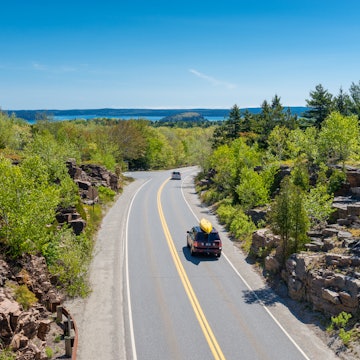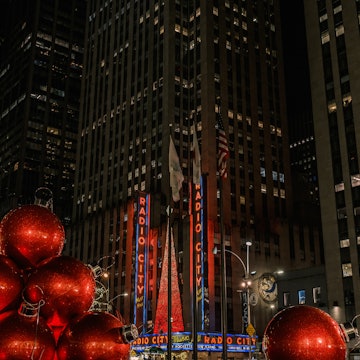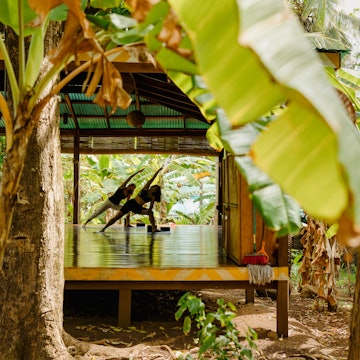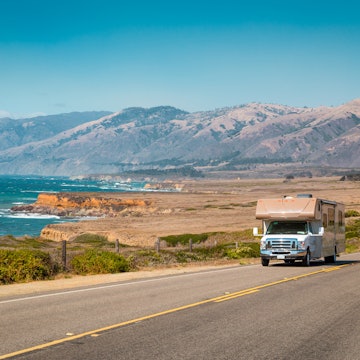

Belvedere Castle right by Turtle Pond in New York City's iconic Central Park © Stefano Giovannini / Lonely Planet
The first public park in the nation and a national historic landmark, Central Park is still where New Yorkers go to get a breath of fresh air and recharge. They’re not alone: thanks to its varied terrain – lush meadows, exposed bedrock, wild woodlands, lakes, gardens and a reservoir – the 843-acre park bursts with biodiversity, including rare flora and fauna. Much like the city that surrounds it, the park hums with history, culture and endless attractions that any traveler will want to see, especially first-time visitors. With so much to explore, it can be overwhelming to decide what to see and do.
Tips for your Central Park trip
Hours: Central Park is open from 6am to 1am daily, so there’s lots of time if you want to use it.
Cost: While there’s no fee for the park itself, activities may have separate costs.
Trails: There are 58 miles of hiking trails in Central Park; the longest loop is 6.1 miles.
Where to enter: There are numerous entry points to the park along Fifth Avenue and Central Park West.
If you’ve spent time on Museum Mile, such as at the Museum of Natural History and want to pop into the park, the best way is the entrance right across Fifth Avenue.
The most photo-worthy entrances are at Columbus Circle or Grand Army Plaza on the south end and Duke Ellington Circle or Frederick Douglass Circle on the north side. These make excellent starting points for exploring on foot.
Transportation: Bikes can be rented from Bike Rent NYC at Fifth Avenue and 60th Street or Central Park South and Central Park West. If bicycles aren’t your thing, electric scooters are also available for rent and can be reserved online in advance.
Accessibility: Many of the trails and paths throughout Central Park have been upgraded to be accessible for those with limited mobility. There are also pedicabs for on-demand hire throughout the park area.
It’s impossible to see the whole park, even with an entire day to explore. Our Central Park guide helps you create a custom itinerary based on your interests and the time you have available.

Can’t-miss spots for a quick visit
Bethesda Fountain and Bethesda Terrace
Located mid-park at 72nd Street, the famed Bethesda Fountain and Bethesda Terrace is an iconic meeting and people-watching spot. Commemorating the first aqueduct to bring fresh water to NYC, the fountain was designed by Emma Stebbins, the first woman to receive a public art commission from the city of New York. Sit, relax, and enjoy the beautiful view. Once you’ve taken it all in, head to Bow Bridge, which is just west of Bethesda Terrace. Famous for appearing in a plethora of Hollywood films, the bridge’s wood deck was replaced in January 2024 to better withstand high levels of foot traffic. It remains a popular spot for marriage proposals, photo shoots and other moments that call for picturesque surroundings.

Strawberry Fields
A 10-minute walk from Bethesda Fountain is Strawberry Fields, a tear-shaped garden and mosaic monument (reading ‘Imagine’) to the late John Lennon, who was assassinated in front of the Dakota apartment building, where he lived, in 1980. His widow Yoko Ono, who lived in the building until 2023, funded the installation.
Alice in Wonderland Statue and Central Park Carousel
Perfect for kids and kids-at-heart, the Alice in Wonderland Statue (on the East side at 75th Street) and the Carousel (mid-park at 65th Street) are popular Central Park destinations that can be visited quickly. The statue is free to enjoy, especially by children who love to scramble among Alice and her friends. The Carousel is open seven days a week, weather permitting. Winter hours: 11am to 5pm. Spring, summer and fall: 11am to 6pm. The cost is $3.25 per person per ride, cash only.
Conservatory Garden
The Conservatory Garden is the most formal and stunning of Central Park’s gardens. It’s tucked away on six acres between E 104th & 106th streets.
Open daily from 8am to 8pm in summer, the elegant, European-styled garden, with its beautiful flowers and fountains and magnificent gated entrance (Vanderbilt Gate once belonged to the largest single-family house in New York City), feels like Central Park’s best-kept secret. It is an excellent place to enjoy a book or breakfast, or rest between museums.
16 things you have to do in New York City
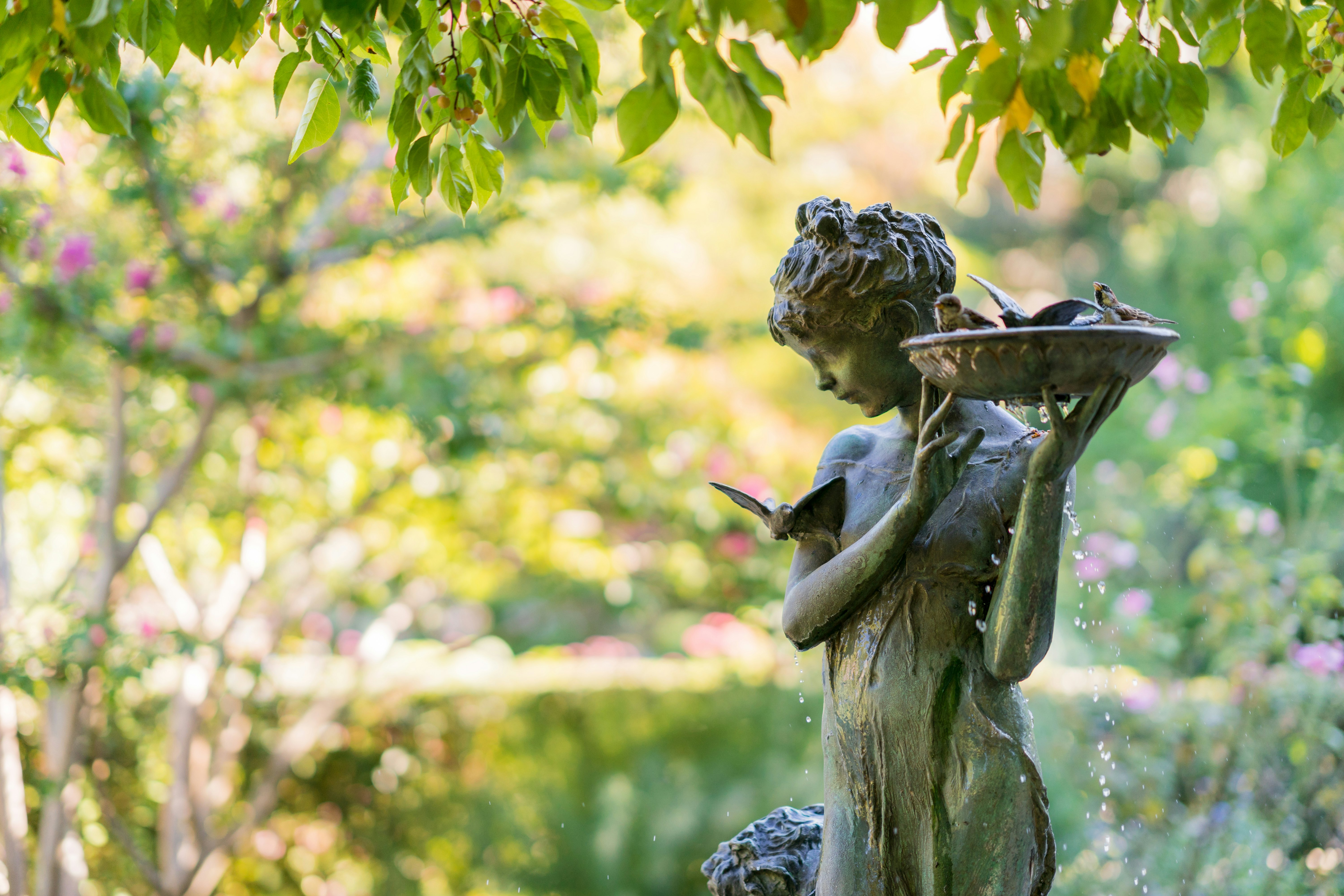
It’s directly across from El Museo del Barrio and the Museum of the City of New York at the north end of Fifth Avenue’s Museum Mile – so you can keep the exploration going if you’re so inclined.
For a half day of exploring
New York Philharmonic in the Park
The New York Philharmonic offers summertime shows on the Great Lawn in the park. You can also download the Ellen Reid SOUNDWALK app – a free immersive audio experience that harmonizes with the park’s landscapes and attractions and was created by the Philharmonic during the pandemic. That way, you can explore the park at your leisure with an epic soundtrack. Try it on your walk to the Conservatory Garden and around the park’s other green spaces.
Recreate your top pop culture moments in Central Park
Grab some friends and recreate famous album covers around Central Park, including: Simon & Garfunkel’s Greatest Hits (east side of the Reservoir), John Lennon & Yoko Ono’s Watching the Wheels (72nd St. & Central Park West) and The Rascals: The Essentials (Bethesda Fountain).
Enjoy the Ramble
In the Mid Park area, cross picture-perfect Bow Bridge to enter one of the park’s most transporting sections, the Ramble. This verdant area features waterfalls, rocky outcroppings, unpaved paths through copses of trees and bird-watchers aplenty. While soaking in this wooded wonderland, remember that every vista, walkway and planting was laid down according to Olmstead’s vision – a merger of the natural world and artistic vision that continues to have no parallel.
You may emerge from the woods by Belvedere Castle, a turreted folly built on a rocky outcropping and a centerpiece of this section of the park. From its terraces, you’ll have a sweeping view of the Great Lawn, an expanse of grass and ballfields that was once a reservoir. Come summer, check the schedule for frequent, and usually free, concerts that take place on the 13-acre lawn; in addition to annual appearances by the New York Philharmonic and the Metropolitan Opera.
Best things to do on Roosevelt Island in New York City
NY Classical Theatre
“Shakespeare in the Fields” (as it’s colloquially/unofficially known) – performed by theatrical group NY Classical Theatre – takes crowds wandering through the bushes and Shakespeare Garden. Tickets are free. After your experience, follow the path out of the Gardens and stop by Belvedere Castle for the beautiful skyline views that stretch in all directions.
Seasonal ice skating and pickleball at Wollman Rink
From October through April, visitors can enjoy outdoor ice skating on the east side of the park. The closest entrance is at 59th and 6th Avenue. The rink itself is just a bit north, at 63rd Street. From May–September, the rink becomes a pickleball court run by CityPickle. Advance reservations for both skating and pickleball are available seasonally online, and rental equipment for both sports is available on-site.
Central Park Zoo
The Central Park Zoo is located at 64th Street and Fifth Avenue and is open daily from 10am. Closing hours vary by season; last entry is one hour before close. Highlights include sea lion and penguin feedings. Discounted tickets are available for seniors and children; children under age 2 are free.
Tavern on the Green
With a focus on local ingredients and seasonal menus, Tavern on the Green is a converted sheep barn formerly known as Sheep Fold. It’s immediately adjacent to Sheep Meadow, a 15-acre lawn popular with sunbathers and picnickers.
Note that the dress code is smart casual, and reservations (recommended) can be made two months in advance. If you’re in the middle of a busy day exploring or prefer to picnic, order food to go.
Central Park Boathouse
Recently redesigned and reopened, the Central Park Boathouse at E 72nd offers fine dining (try for the first-come, first-served dockside tables), a cafe, and a classic Central Park experience. Rowboat rentals from Loeb Boathouse are $25/hour, and life jackets are included.
Go birdwatching
Bring your binoculars – Central Park is one of the best places to go bird watching not only in New York City, but in the entire US. Over 210 species make an appearance throughout the year.
Why birding is taking flight with a new generation
Central Park is situated along the Atlantic Flyway (a major migratory route for birds between North and South America). It’s busiest during the first two weeks of May, when birds fly north, and from August through September when birds start returning south.
Within the park, the best locations for spotting birds (and meeting fellow birders) are in the far northern sections of the park – North Woods, Ravine and the Ramble.
If you have the whole day
Try foraging
According to “Wildman” Steve Brill, Central Park is home to over 100 medicinal and edible plants, from the American persimmon to the Kentucky coffee tree. Brill leads half-day tours that can easily be combined with exploring other parts of the park. Note that foraging in the park on your own, outside of a tour, is not permitted.
Summit One Vanderbilt: Why I loved this new -- and definitely different -- NYC observatory

Summer is best for berries - think black raspberries, mulberries, juneberries and wineberries - while fall is best for mushrooms and nuts. While a $20 donation per adult is suggested, guests are welcome to donate more if they can afford it, or pay less if they can’t. You can also download his Wild Edibles app (the ‘Lite Version’ is free). Worried about sustainability? Brill has been picking in the same spots across Central Park for over 40 years, and there’s just as much there now as there was in 1982.
Explore the quieter north end
The crowds thin out as you head north – which makes a wander through the North Woods all the more magical. Olmstead and Vaux enhanced the area’s varied topography with stone pathways, water features and hillside passages; as the skyline completely disappears and the trees envelop you, you’ll find it
hard to believe you’re in Manhattan. (Keep an eye out for the Blockhouse, a fortification from the War of 1812 that’s the single oldest structure in the park.) Enclosed by a wrought iron fence, the beautiful Conservatory Garden has a totally different feel from the surrounding landscapes, with its French-style formality and neatly planted flowers.
New York City's best neighborhoods for shopping

Springbanks Arch
After relaxing in the beautiful Conservatory Garden, take the E 102nd entrance and walk west, passing the baseball fields. Sounds of gushing spring water usher you into the wilderness that is the Ravine, where the only skyscrapers you can see are tall oak, elm and maple trees.
Wandering along the narrow waterway, known as the Loch, look for meditative waterfalls (all designed by the park’s original designers Frederick Law Olmsted and Calvert B. Vaux) and wildlife, like snapping turtles and hawks. Continue until you reach the 40-acre North Woods, the largest of the park’s three woodland landscapes, a popular spot among bird watchers and naturalists. After taking yourself on a free self-guided tour, bid adieu to the area labeled the “Adirondacks” via the rustic Huddlestone Arch, made entirely of massive boulders, which thrusts you out and returns you to “civilization”.
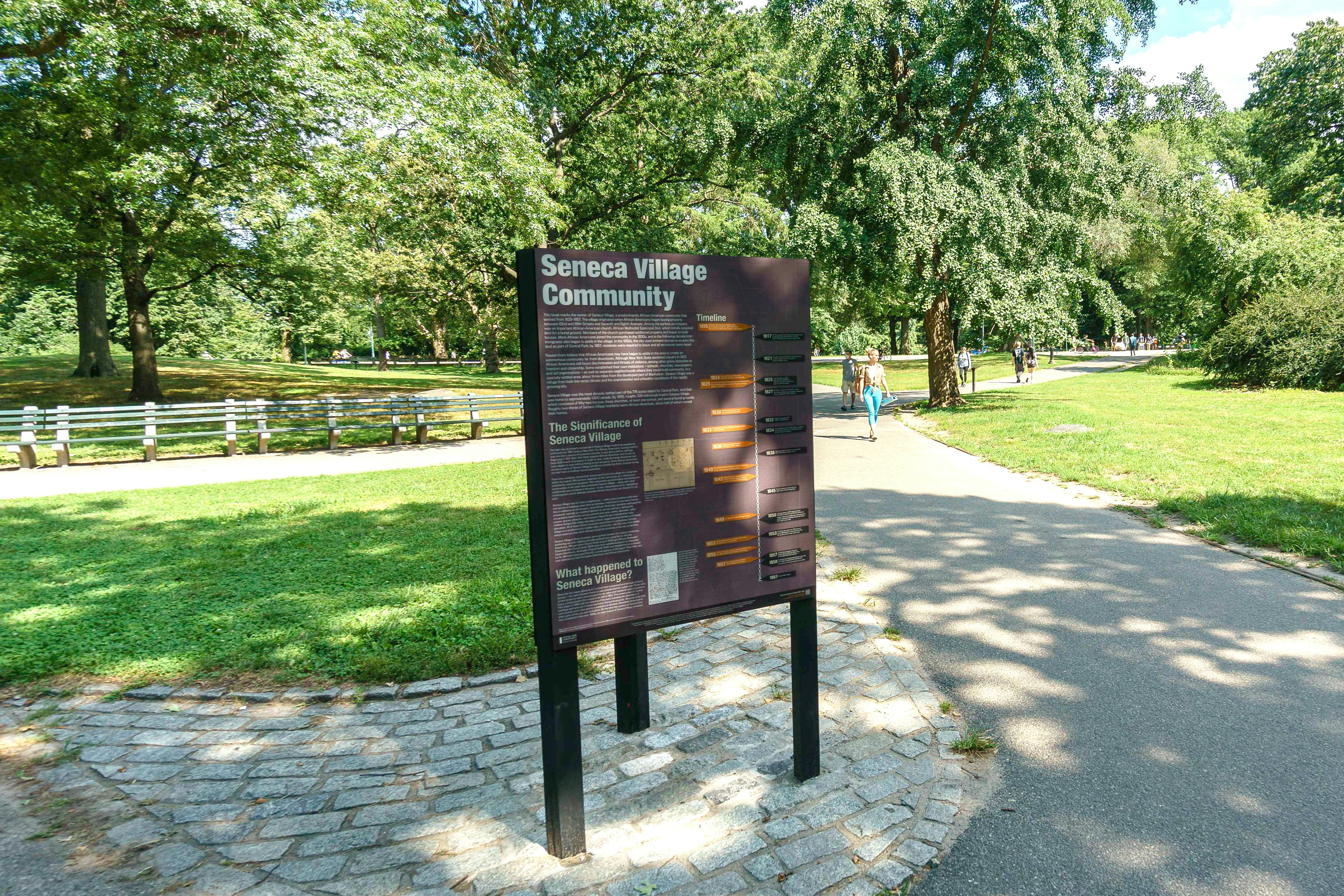
Picnic and play on the Great Hill
Make your way west to the Great Hill between 103rd and 107th, one of the highest natural points in Central Park, and continue south for twenty blocks along the park’s west side, passing the tennis courts and Reservoir, known for its scenic running track and beautiful view. The 1.58 mile loop offers wonderful views of both the reservoir itself and the cityscape. No pets, strollers, or bicycles are allowed on the track. If you’re visiting in the spring, there are 35 cherry blossom trees along the route. Bring a picnic blanket and to-go food for a midday rest on the Great Lawn or the Arthur Ross Pinetum.
You’ll then reach one of the most significant historical sites in the entire park: the Seneca Village site. Founded in 1825, Seneca Village was a refuge from the chaos and grit of the city downtown – until an 1853 New York State law uprooted its residents and razed the village for the creation of Central Park. While this allowed the government to acquire private land for public use through eminent domain – a common practice back then, compensating landowners in the process – many of Seneca Village’s 225 displaced residents were outraged, claiming their land was undervalued, according to the Central Park Conservancy.
8 of the best vegan restaurants in NYC that are a fraction of the price of Eleven Madison Park








